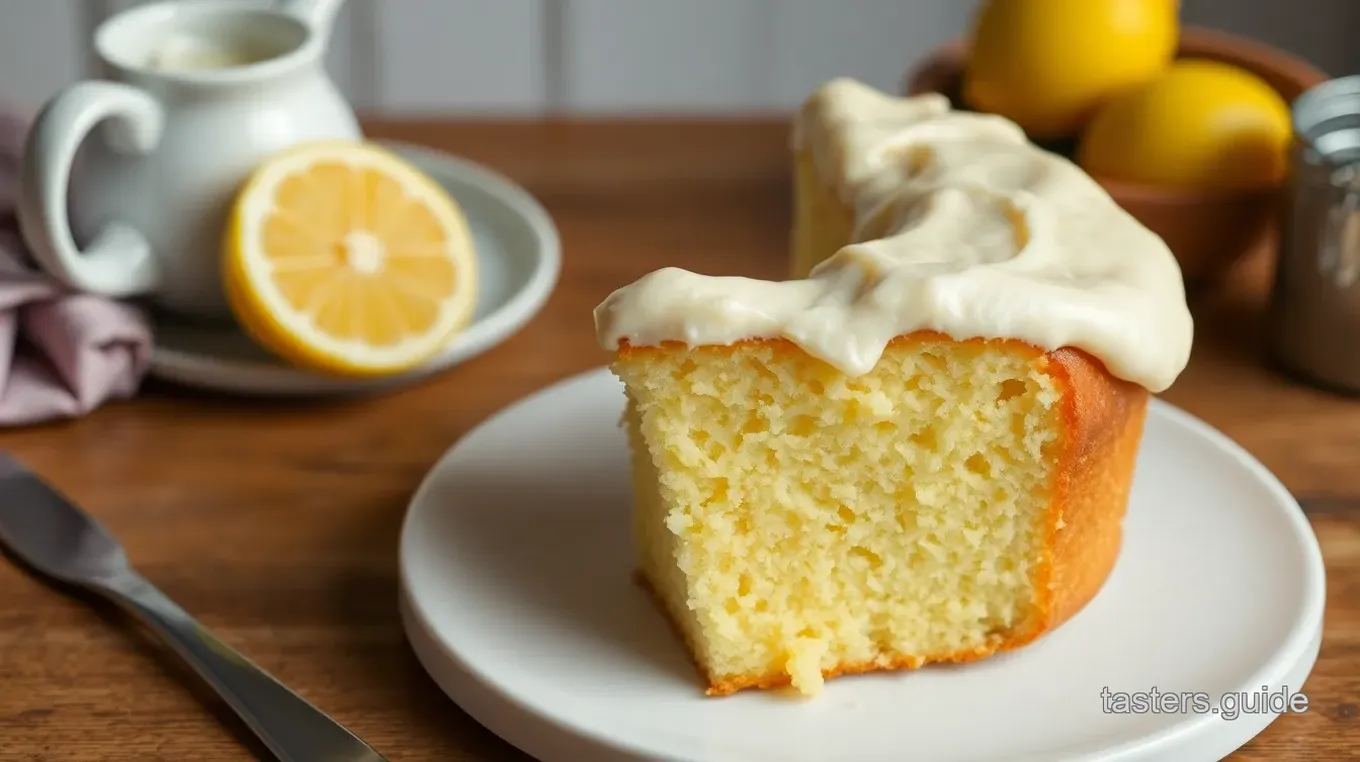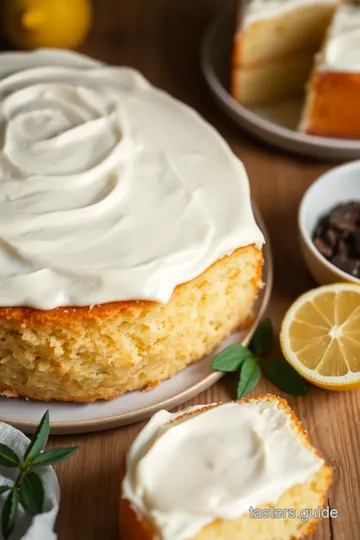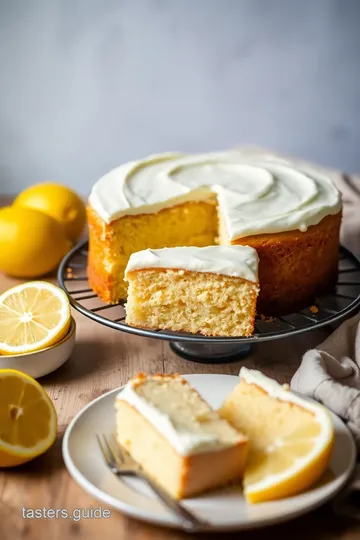Bake Lemon Cake with Creamy Frosting Bliss
Wondering how to elevate your dessert game? Try my Bake Lemon Cake with Creamy Frosting Bliss—it's bright, moist, and bursting with lemony goodness!

- A Slice of Sunshine: Bake Lemon Cake with Creamy Frosting Bliss
- From Old World to Modern Delight
- Why You Need This Cake in Your Life
- Essential Ingredients Guide
- Whipping Up the Perfect Lemon Cake: Your Go-To Guide!
- Pro Tips & Secrets
- Perfect Presentation
- Storage & Make-Ahead
- Creative Variations
- Complete Nutrition Guide
- Expert FAQ Solutions
- Recipe Card
A Slice of Sunshine: Bake Lemon Cake with Creamy Frosting Bliss
Oh my gosh, have you ever had a dessert that made you feel all warm and fuzzy inside? i remember the first time i tried a lemon cake at a summer picnic.
It was like a burst of sunshine on my plate! just thinking about that zesty goodness makes my mouth water.
There’s something about the bright, fresh lemon flavor that dances around with sweetness. that's why i'm excited to share with you how to bake lemon cake with creamy frosting bliss! trust me, you’re going to want this recipe in your back pocket, especially for those special occasions when you want to impress.
From Old World to Modern Delight
Lemon cake has a rich history rooted in european baking traditions. back in the day, bakers would use fresh citrus in their desserts to bring a little zest to life.
Fast forward to today, and it’s still a favorite among us dessert lovers. it’s not just a cake; it’s a celebration on a plate .
Whether you’re throwing a birthday bash or just want to brighten up a tuesday, this moist lemon cake fits the bill.
It usually takes about an hour from prep to feast, and don’t worry—while it might sound fancy, the difficulty level is a solid medium.
If you can mix and bake, you’ve got this!
Now, let's talk cost. this delightful cake won't break the bank! most of the ingredients are pantry staples. you're looking at a yield of around 12 servings , so it’s fantastic for gatherings or just to have a sweet treat handy at home.
Why You Need This Cake in Your Life
First things first, let’s chat about the health benefits . lemons aren’t just for lemonade! they’re packed with vitamin c and antioxidants.
The zest gives you that pop of flavor and also has its own health perks. some studies even suggest lemon zest can help improve digestion.
Added bonus!
Now, this is not just any lemon cake; it’s a star at special occasions. imagine serving this cake at your next family gathering.
Everyone’s wowed by the layered beauty, and then that first bite? pure bliss. what’s cooler is that it stands out against other classic lemon desserts with its creamy frosting that adds a touch of indulgence that you don't get from a simple slice of cake.
The Secret to Success
Let’s not forget why you might choose this recipe over similar ones. the balance of sweet and tart makes this cake irresistible .
It’s light, fluffy, and moist—everything you want in a cake. want to play around? go for some lemon cake variations by adding poppy seeds for texture, or even swirl in fresh blueberries.
Yes, please!
Baking Tips
When you prepare to bake, consider this: do your ingredients have room temperature? trust me; this matters more than people think.
Also, using fresh lemons will amplify that natural lemon flavor. and, always, i mean always let your cake cool before you dive into frosting! if you skip that part, your frosting could just slide right off.
Yikes!
Now that you’re ready to dive into the world of zesty cake goodness, let’s get to the ingredients. Grab your baking equipment , and we’ll make this delicious Bake Lemon Cake with Creamy Frosting Bliss happen together!

Essential Ingredients Guide
When it comes to baking, having the right ingredients is everything . seriously! we’re diving into a world of flavors, textures, and that irresistible aroma wafting from your oven — especially when you're about to bake lemon cake with creamy frosting bliss .
This guide covers the essential components you need, plus some nifty tips to keep your kitchen game strong.
Premium Core Components
First up, let's lay down the law on your premium core ingredients . Always stick to these guidelines for that perfect taste.
-
Measurements : Keep your scale handy! For your lemon cake, we’re talking 2 cups (240g) of all-purpose flour and 1 ½ cups (300g) of granulated sugar. Precision matters folks!
-
Quality Indicators : Use the freshest ingredients possible. For lemon zest benefits, you want to use organic lemons. Trust me, it’ll elevate your moist lemon cake from “meh” to “oh my goodness!”
-
Storage Guidelines : Keep your butter soft, your eggs chilled, and flour in a cool, dry place. Your baking essentials can last months, but for best results, check the dates.
-
Freshness Tips : Always smell your ingredients. If your vanilla extract smells flat or your baking powder feels gritty, toss ‘em. Freshness is key for light and fluffy cakes.
Signature Seasoning Blend
Next, let’s tackle that signature seasoning blend . This is where your cake goes from basic to wow .
-
Essential Spice Combinations : Beyond lemons, add a touch of salt; it enhances flavors beautifully.
-
Herb Selections : Try rosemary with lemon in your recipes sometime. They’re best buds if you ask me!
-
Flavor Enhancers : For that fresh lemon frosting , a dash of almond extract pairs wonderfully with vanilla.
-
Regional Variations : This is your chance to spice it up! Consider adding some cardamom or ginger for a new twist on classic lemon desserts.
Smart Substitutions
Now, life happens; you've gotta be flexible. Enter smart substitutions .
-
Common Alternatives : No whole milk? Use buttermilk! It's creamier and adds a slight tang to your lemon cake.
-
Dietary Modifications : You can go gluten-free by subbing in almond flour or a gluten-free blend.
-
Emergency Replacements : Running out of eggs? Flaxseed meal with water can save the day but, keep in mind, it might change the texture a bit.
-
Seasonal Options : Experiment with seasonal fruits! Blueberry lemon combinations or fresh strawberries make each bite feel like a burst of sunshine.
Kitchen Equipment Essentials
Now let’s chat about the must-have tools . You don’t need a fancy kitchen to whip up something extraordinary.
-
Must-Have Tools : Grab yourself some good mixing bowls, an electric mixer (if you want to save those arm muscles), and rubber spatulas - these are your baking besties.
-
Alternative Equipment Options : No cake pans? Baking in muffin tins works too. Just adjust your baking time - think about 20- 25 minutes for cupcakes.
-
Preparation Tips : Always preheat your oven to 350° F ( 175° C) so your cake rises perfectly.
-
Storage Solutions : Keep your tools organized. I stick my measuring cups in a drawer like my secret army of baking warriors.
Now that we’ve explored the essential ingredients and tools, it’s time to get our hands dirty and dive into those instructions! you’re just a few steps away from creating a zesty masterpiece that will leave your family drooling and your gatherings unforgettable.
Let’s make that bake lemon cake with creamy frosting bliss happen!
Whipping Up the Perfect Lemon Cake: Your Go-To Guide!
Oh my gosh, let’s talk lemon cake! you know, not just any cake—i'm talking about that bake lemon cake with creamy frosting bliss that makes you say, "yessssss!" every time a slice crosses your lips.
It’s not just a dessert; it’s a zesty experience that can turn a regular day into a celebration. so, let’s dive into the professional cooking methods to create this moist lemon cake bursting with flavor!
Essential Prep Steps
Let’s start with mise en place . you don’t wanna be running around the kitchen looking for measuring cups mid-bake. gather everything: flour, butter, eggs, lemon zest – you name it.
It’s like setting the stage for a great performance!
Time management is key! spend about 20 minutes gathering your ingredients and tools, and keep a close eye on the clock during baking.
Prepping ahead helps you stay calm and collected. you know those bakers on cooking shows? they look so relaxed because they have everything sorted out.
When it comes to organization strategies , i like to line up my ingredients in the order they’ll go into the bowl.
And hey, safety first! keep clean surfaces and avoid cross-contamination. no one wants lemon-flavored salmonella!
Step-by-Step Process
Here’s how to whip up this beauty!
-
Preheat your oven to 350° F ( 175° C) . Don’t skip this step. A good oven makes a world of difference!
-
Mix your dry ingredients . Whisk together 2 cups of flour, 1 tbsp baking powder, and a pinch of salt in a medium bowl. That’s your base, folks.
-
In a new bowl, cream ½ cup softened butter and 1 ½ cups sugar until fluffy. This is where the magic begins!
-
Now, add in 3 eggs one at a time. Trust me, this gives your cake that light and fluffy texture we’re aiming for.
-
Pour in 1 cup of milk, ⅓ cup of fresh lemon juice, and zest from 2 lemons . The more zest, the better, right?
-
Next, gradually mix in the dry ingredients . Be gentle. We don’t want gluten overboard!
-
Divide the batter into two 9-inch pans and bake for 30- 35 minutes . Look for that toothpick test—if it comes out clean, it’s go-time!
-
Let them cool for 10 minutes in the pans before flipping them onto a cooling rack. Trust me, you’ll want them cool before slathering on that frosting.
Frosting Time!
Your cake is cooling, but don’t even think of wandering off! in a medium bowl, beat 1 cup softened butter until creamy, then gradually add 4 cups powdered sugar and ¼ cup heavy cream .
A dash of vanilla goes in too! you want that fresh lemon frosting to have the right balance of sweetness and creaminess.
Expert Techniques
Quality checkpoints to keep in mind: your butter should be at room temp (makes mixing easier), and your powdered sugar should be sifted. This ensures a nice, smooth frosting.
When in doubt, troubleshoot! If your frosting is too thick, add a bit more cream. Too runny? A little more sugar won’t hurt.
Success Strategies
Talking from my own experience here, one common mistake is not waiting for the cake to cool! i mean, who hasn’t tried to frost a warm cake? let’s just say it doesn’t end well.
Check quality along the way. You wanna impress your friends and family, right?
Oh, and planning ahead? This cake can be baked a day in advance and frosted just before serving. Trust me—this is a real lifesaver!
Wrapping It Up
In conclusion, the bake lemon cake with creamy frosting bliss isn’t just a recipe; it’s an experience. with a sprinkle of lemon zest and a dollop of love, you can create something extraordinary.
So, gather your kitchen equipment, set your ovens, and get ready to indulge in a slice of heavenly bliss that’s perfect for all those special occasions or a sweet treat to brighten up your everyday routine!
Stay tuned for Additional Information where I’ll dish out some more tips, variations, and serving suggestions to keep your baking game strong!

Pro Tips & Secrets
Alright, let’s dive right into some pro tips for your bake lemon cake with creamy frosting bliss . first off, i can’t stress enough how important room temperature ingredients are for a light and fluffy cake.
I used to skip this, thinking it wouldn't matter, but trust me, it really makes a difference—your lemon cake will thank you.
Now, for a time-saving technique , prep your pans and ingredients ahead of time. measure everything out before you start mixing.
It’s like a pregame warm-up; you’ll avoid any last-minute scrambles. and when it comes to flavors, a little extra lemon zest goes a long way.
Seriously, don’t hold back! it enhances that natural lemon flavor and gives your cake a zesty kick.
Want to take it up a notch? for the presentation , consider using a clean serrated knife to slice your cake.
This makes those pieces look bakery-ready. and don’t skimp on garnishing! a sprinkle of lemon zest on top not only looks stunning but adds a fresh burst right when you take a bite.
Perfect Presentation
Speaking of presentation, let’s get into some plating techniques . when you’ve frosted your cake, place it on a clean white plate.
The bright yellow and creamy frosting pop beautifully against that backdrop—like the sun on a clear day. i personally love to use color combinations , maybe toss some fresh blueberries around the base for a sweet contrast with the moist lemon cake and elevate the visual appeal.
And listen, don’t underestimate the power of a decorative cake idea . a simple lemon slice or edible flowers can look oh-so-fancy.
It’s like inviting your cake to prom—it deserves to look its best!
Storage & Make-Ahead
Now, about storage : if you have leftovers (which is rare because it’s so good), wrap them tightly in plastic wrap or store in an airtight container.
Your lemon cake can last about 3 days at room temperature but will keep in the fridge for about a week if necessary.
Planning ahead? great idea! you can make the cake a day or two in advance and store it without frosting.
This actually makes it easier! just frost it on the day you plan to serve (less sogginess that way). and if you need to reheat, a gentle zap in the microwave for 10-15 seconds should do the trick for those who love a warm slice.
Creative Variations
Let’s talk creative variations for your cake. feeling a bit adventurous? try adding blueberries for that classic blueberry lemon combination or toss in poppy seeds for that delightful crunch.
You can even use a gluten-free flour blend if necessary; your friends will never know the difference.
And seasonal twists? how about making a spiced lemon cake in the fall with a dash of cinnamon? talk about creating a sweet treat for gatherings ! you can modify the frosting too; a swig of orange juice could turn your creamy frosting recipe into something equally dreamy with just a hint of citrus pop.
Complete Nutrition Guide
Alright, let’s break this down with a complete nutrition guide . each slice of this beauty hovers around 450 calories , but don’t shy away from it! it’s a mix of carbs, proteins, and healthy fats, plus packed with all the lemon zest benefits .
Now, indulge wisely. if you’re keeping an eye on sugar, consider cutting back on the powdered sugar in the frosting.
And how about that portion guidance? i usually slice this cake into 12 pieces —perfect for family or even potlucks.
Expert FAQ Solutions
You might have some burning questions. like, “what if my cake doesn’t rise?” okay, here's a tip: check the baking powder —it works hard, but it can't last forever.
If it’s been around since stone age, toss it! and if your cake was a bit flat, don’t sweat it.
Bake it again, but this time, trust the baking time and temperature .
Got more questions? Hit me up! Baking is a learning curve, and I’ve had my fair share of epic fails, so I totally understand.
So there you have it! making a scrumptious bake lemon cake with creamy frosting bliss is totally within your reach.
With these tips, you’ll be whipping up a moist lemon cake that’s sure to impress anyone who gets a slice.
Whether it’s for a special occasion or just a tuesday night pick-me-up, this cake is a fantastic choice that brings a little sunshine to your table.
So grab your kitchen gear and get baking—your sweet tooth will thank you!

Bake Lemon Cake with Creamy Frosting Bliss Card

⚖️ Ingredients:
- 2 cups all-purpose flour (240g)
- 1 ½ cups granulated sugar (300g)
- ½ cup unsalted butter, softened (115g)
- 1 cup whole milk (240ml)
- 3 large eggs
- Zest of 2 large lemons
- ⅓ cup fresh lemon juice (80ml)
- 1 tablespoon baking powder
- ½ teaspoon salt
- 1 teaspoon vanilla extract
- 1 cup unsalted butter, softened (230g)
- 4 cups powdered sugar (480g)
- ¼ cup heavy cream (60ml)
- 1 teaspoon vanilla extract
- Zest of 1 lemon (optional, for garnish)
- A pinch of salt
🥄 Instructions:
- Step 1: Preheat your oven to 350°F (175°C). Grease and flour the cake pans.
- Step 2: In a medium bowl, whisk together flour, baking powder, and salt.
- Step 3: In a large mixing bowl, cream softened butter and granulated sugar until light and fluffy.
- Step 4: Add eggs one at a time, mixing well after each addition. Incorporate lemon zest, lemon juice, milk, and vanilla extract.
- Step 5: Gradually add dry ingredients to wet mixtures, mixing until just combined. Do not overmix.
- Step 6: Divide the batter evenly between the prepared cake pans. Bake for 30-35 minutes, or until a toothpick comes out clean.
- Step 7: Remove from oven and let cool in pans for 10 minutes. Invert onto cooling racks to cool completely.
- Step 8: In a mixing bowl, beat softened butter until creamy. Gradually add powdered sugar, alternating with heavy cream and vanilla. Beat until smooth.
- Step 9: Once cakes are completely cooled, place one layer on a serving plate. Spread frosting on top, add the second layer, and frost the top and sides.
- Step 10: Optional: Garnish with additional lemon zest. Slice and enjoy!
Previous Recipe: How to Bake Vanilla Bundt Cake in 45 Minutes: Ultimate Family Delight
Next Recipe: Easy No-Bake Tres Leches Cake with Cardamom Flavor: My Secret Indulgence
